Part 4: The issues that councils consulted on
4.1
In this Part, we consider the issues councils consulted on in the consultation documents.17 We discuss:
- the number of issues presented to communities;
- the types of issues;
- how councils are consulting with their communities on water management and providing water services; and
- how resilience had been addressed in the consultation documents.
4.2
We focused specifically on water-related issues because we have an interest in how well public organisations, including councils, are carrying out their water management roles and responsibilities.18
Number of issues
4.3
We had to use judgement when collating all the issues presented to communities in the consultation documents. This is because consultation documents are not presented in a consistent way.
4.4
For the purposes of this Part, we counted as consultation issues only those matters presented in the consultation document that included a range of options. We also counted issues included in the feedback and submission forms that set out a range of choices, although these might have been less clear in the main part of the consultation document.
4.5
Overall, we counted 376 issues that were presented to the public. The average number of consultation issues presented by each council was five, and the number of issues ranged from one to 13.
4.6
Upper Hutt City Council presented 13 optional projects as issues to its community and asked whether the projects were supported. They also asked the community in the feedback form whether they supported rates and debt increases linked to completion of all, some of, or none of the optional projects.
4.7
The consultation document was focused on "optional projects that will significantly increase investment in the city, and focus on lifestyle opportunities for a resilient, vibrant and growing city". The document explained that "business-as-usual" plans would keep the city fit-for-purpose and running smoothly and noted that the document focused on the main initiatives planned. The issues presented were predominantly related to community facility developments or improvements. All of these issues were presented in a 24-page document. We would have preferred to see the issues better follow the requirements of the Act about implications of options but, because the issues were presented as "add-ons" to business as usual, we considered that a binary "yes" or "no" choice was workable.
4.8
Far North District Council's consultation document was 40 pages long and included 12 issues that were presented with options for consideration by the community. The issues were presented from pages 20 to 31. Several sections of the consultation document provided updates on previously consulted issues, policy changes, and issues that will affect the long-term plan. For example, the Council listed the extra operational and capital costs that will be incurred to implement the 10-year library strategy. The Council wanted to check in again with the community to confirm these costs align with their desire for a modernised library service.
4.9
The consultation document included a good mixture of graphs, diagrams, and photos. Overall, we considered there were many issues presented in this consultation document and we questioned whether a member of the public trying to understand the issues would have been able to take in the implications of the issues as a whole. However, we recognise that because most of the issues were about community facilities or localised infrastructure issues, the reader would have a personal interest and be able to understand the implications for them.
Types of issues
4.10
We reviewed the issues that were presented to communities throughout the country. Figure 3 shows the number of issues by category.
Figure 3
Number of issues presented to communities in the 2018-28 consultation documents, by category
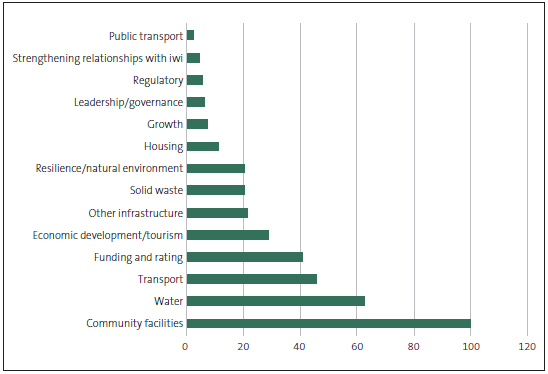
Source: Our analysis of the 2018-28 consultation documents.
4.11
Figures 4, 5, 6, and 7 show a further breakdown of the four largest categories: funding and rating, transport, water, and community facilities.
4.12
Figure 4 shows that affordability remains a main concern for the funding and rating category. There was a focus on how the rating system is structured to manage perceptions of affordability and fair splitting of the total rates collected from the community.
Figure 4
Funding and rating issues presented to communities in the 2018-28 consultation documents
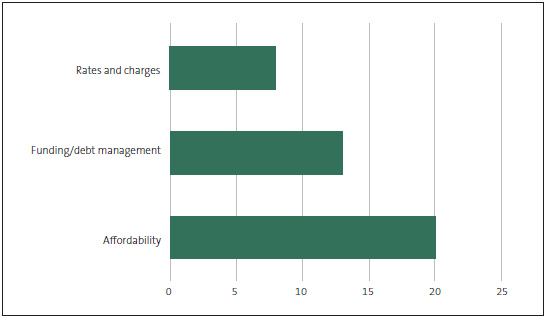
Source: Our analysis of the 2018-28 consultation documents.
4.13
Transport issues also featured strongly. The issues presented include road construction, renewal approaches, bridge issues, and traffic (see Figure 5). Cycle lanes and trails and other work to support cycling also featured quite strongly.
Figure 5
Transport issues presented to communities in the 2018-28 consultation documents
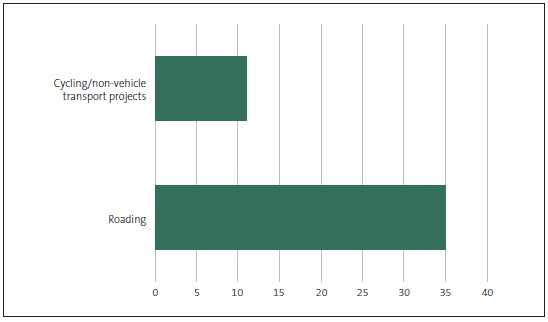
Source: Our analysis of the 2018-28 consultation documents.
4.14
Figure 6 shows that the largest category of water issues was water supply. Many of these issues were related to councils' responses to the Havelock North Drinking Water Inquiry.
Figure 6
Water issues presented to communities in the 2018-28 consultation documents
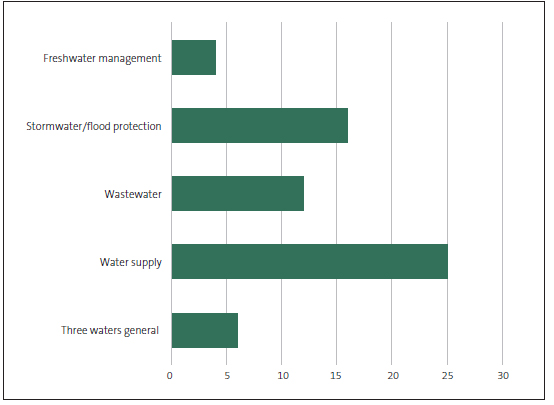
Source: Our analysis of the 2018-28 consultation documents.
4.15
Many issues were related to community facilities or providing community activities (see Figure 7). We attribute this increase of issues about community activities, which could be described as discretionary or "nice to have", to two factors:
- a view that a healthy community needs to include quality community facilities and activities; and/or
- increased use of the consultation document to present smaller proposals of public interest to the community.
Figure 7
Community facilities issues presented to communities in the 2018-28 consultation documents
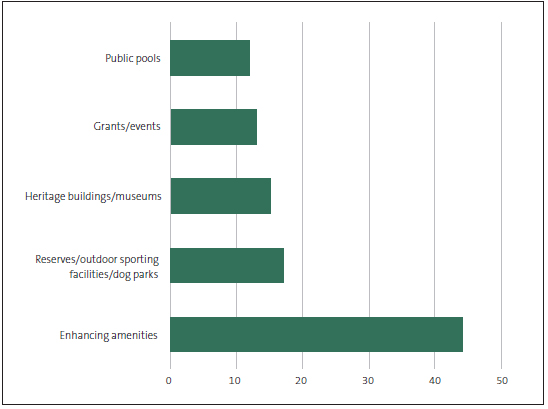
Source: Our analysis of the 2018-28 consultation documents.
Water-related issues
4.16
Fifty councils specifically consulted on water-related proposals with their communities. We have categorised these proposals as:
- three waters general;
- wastewater;
- water supply;
- stormwater;
- flood protection; and
- freshwater management.
Drinking-water supply
4.17
Drinking-water supply was the most consulted on water-related issue. Many councils had proposals that responded proactively to the Havelock North Drinking Water Inquiry recommendations. The Havelock North Drinking Water Inquiry recommended that:
[T]he Director-General of Health can and should, in the interests of public safety and welfare, exercise effective and practical leadership to encourage water suppliers to use appropriate and effective treatment without delay.19
4.18
The Director-General of Health issued such a statement in December 2017.
4.19
Some councils have responded by consulting on proposed programmes of work to meet the New Zealand Drinking-water Standards. These proposed work programmes particularly focused on smaller community water supplies, and being ready to meet anticipated higher standards. A few councils proposed bringing forward their work programmes.
4.20
Several councils indicated that they were chlorinating or planning to chlorinate their water supplies. Other councils made financial provisions in their proposed long-term plan but are waiting until requirements are confirmed after the Government responds to the Havelock North Drinking Water Inquiry.
4.21
Security of water supply was also a prominent consultation issue. The options included building more infrastructure to facilitate supply after a major event such as an earthquake, finding a new water supply in response to growth pressures or the effects of climate change (such as less rainfall), and investing in water conservation and water metering to reduce water usage.
Freshwater quality
4.22
Six regional councils and two unitary authorities consulted on proposals to improve freshwater quality. Proposals covered activities to support a community-led catchment management approach, on the ground activities such as riparian planting, carrying out more monitoring to improve councils' understanding of the state of freshwater, and targeted rates to accelerate programmes of work.
4.23
A main reason for these proposals is the requirement for regional councils to give effect to the National Policy Statement for Freshwater Management by 2025.
4.24
We will publish a report later in 2018 that looks at the progress Waikato, Taranaki, Horizons, and Southland Regional Councils have made on freshwater quality management since our last audit in 2011.
Wastewater and stormwater – responding to increasing environmental standards
4.25
As regional councils progressively respond to the requirements of the National Policy Statement for Freshwater Management by 2025, higher standards for wastewater and stormwater discharges are either in place or due to be in place in regional plans.
4.26
Higher standards have implications for the management of councils' stormwater and wastewater networks, including the renewal of resource consents. Some councils indicated in their consultation documents that they would need to invest more in improving the quality of their wastewater and stormwater discharges. This includes activities such as upgrading their wastewater treatment plants and addressing the inflow and infiltration of stormwater into the wastewater network.
4.27
Several councils' existing wastewater and stormwater discharge consents are due to be renewed in the next 10 years. Some councils highlighted the cost pressures of having to meet increasing environmental standards, which is compounded by ageing infrastructure. For example, Southland District Council noted its communities are geographically dispersed with a low ratepayer base.
4.28
We will publish a report later in 2018 that looks at how well local authorities are managing their stormwater networks to reduce flood risk, including how councils identify their flood hazards and determine levels of service for the stormwater network.
Addressing resilience
4.29
We considered how resilience had been addressed in the consultation documents. We identified how councils have discussed their approach to addressing the effects of climate change and natural hazards events in the management of their infrastructure and service delivery more generally.
4.30
Recent significant natural hazard events20 highlight the need for councils to understand the level of risk that they are exposed to. Councils also need to understand the influence that climate change has on the level of risk.
Resilience as a significant consultation issue
4.31
Four councils consulted specifically on resilience-related issues.21 These councils consulted on activities to understand risk exposure and investments in improving infrastructure resilience.
4.32
Two councils also consulted on how to execute their emergency management functions and the level of funding to contribute.
General consideration of resilience
4.33
Most councils acknowledge the need to consider the effects of climate change and risks from natural hazards in managing their infrastructure. They noted in their consultation documents that they are considering how to continue providing drinking water, dispose of wastewater, and keep people safe from flooding given the risks from natural hazards and the effects of climate change.
4.34
Many consultation documents included a discussion about the need for a council and its community to understand its exposure to risks from natural hazards and the effects of climate change. Activities noted to improve the understanding and management of these risks included stormwater modelling, addressing under-capacity networks, and financial management options to be able to respond to adverse events. For example, Waimakariri District Council identifies in its borrowing policy that it can use $84 million to respond to a natural disaster.
4.35
Our observations are that councils are developing an understanding of their exposure to risk that will then inform investment decision-making for long-term planning processes.
4.36
Figure 8 lists examples of water-related and resilience issues that councils consulted on with their communities and provides examples.
Figure 8
Examples of water-related and resilience issues that councils consulted on with their communities
| Consultation issue | Council consultation examples |
|---|---|
Three waters general |
Waikato District Council consulted on which governance model to apply to providing three waters services, noting the challenges of providing these services with growth pressures, tougher standards to be met (they refer to the Havelock North Drinking Water Inquiry), and a shortage of skilled staff. The Council's preferred option is for a council-appointed waters governance board.* Central Hawke's Bay District Council, Christchurch City Council, Southland District Council, and Waimakariri District Council consulted on their water work programmes as a whole from a funding and affordability perspective and the level of service that the community was willing to pay for. |
Wastewater |
Tararua District Council noted in its consultation document that it needs to upgrade the Eketahuna wastewater treatment plant to meet the regional plan requirements. The Council consulted on options of building a wastewater pipeline from Eketahuna to Pahiatua wastewater treatment plant or building a new wastewater treatment plant and wetland in Eketahuna. The Council's preference is the former at a cost of $3.6 million, funded by a loan over 20 years. The level of service will remain the same but building the pipeline will avoid the need to obtain a discharge consent for Eketahuna. Wairoa District Council's wastewater discharge consent will expire in 2019. The Council is proposing to transition to a land-based discharge, which would cost $6.5 million ($4.5 million loan-funded and $2 million from reserves). |
 Water supply |
Tasman District Council consulted on improving the security and supply of drinking water, and how to fund Motueka's water supply in order to comply with the New Zealand Drinking Water Standards. Greater Wellington Regional Council consulted on whether it should continue proposed support for the Water Wairarapa Project. The Council's preference is to continue funding the management of the programme and complete investigations at a cost of $200,000 in 2018/19. |
 Stormwater |
Waimakariri District Council noted that each major town in the district requires a stormwater discharge consent. The Council's preliminary estimates suggest it might cost up to $100 million over the next 30 years to meet the standards required under the discharge consents. The likely effect on rates would be about $200 to $250 for each property each year. Kapiti Coast District Council consulted on refocusing its stormwater management programme. The programme as set out in the 2015-25 long-term plan would have taken 60 years to complete. After two major flood events in 2015, the Council carried out investigations to better understand its flood risk exposure. The Council proposed a larger programme with a bigger budget to focus on areas of risk and cater for estimated population growth. The Council decided that 45 years was the most affordable time frame to complete the programme. |
 Flood protection |
Bay of Plenty Regional Council consulted on a rivers and drainage flood recovery project. The consultation document noted that the Council has changed its financial strategy and the Council would take on external debt of $157 million to help fund the capital works programme, including the works required in response to the April 2017 Edgecumbe flood event and the findings and recommendation of the Rangitāiki River Scheme Review. Southland Regional Council consulted on the proposed upgrade of urban stopbanks. |
 Freshwater management |
Auckland Council's preferred option is to apply a targeted rate to accelerate the water quality work programme – $66 each year for the average residential property and $308 a year for the average business property. A main reason for this proposal was the number of wastewater overflows and stormwater discharges into the harbours, resulting in swimming beach closures. Southland Regional Council proposed a new water improvement rate to support the implementation of its People, Water and Land programme, which includes on-the-ground action and meeting the requirements of the National Policy Statement for Freshwater Management. Northland and Otago Regional Councils proposed spending more on monitoring with an increased number of monitoring sites. |
 Resilience |
Otago Regional Council consulted on planning for and making changes to prepare for the effects of climate change. The Council's preferred option is to do projects focusing on the effects of sea level rise in South Dunedin and the Clutha Delta and to initiate a risk assessment programme to scope and prepare for the effects of climate change on all areas in Otago. Tauranga City Council consulted on funding for a better understanding of resilience through a targeted rate. Marlborough District Council consulted on the timing and priority for rebuilding after a significant emergency event and what was the preferred emergency reserves balance. |
* Waipa District, Waikato District, and Hamilton City Councils had worked over a number of years on a proposal to establish a council-controlled organisation for water management in the Waikato region. Waipa District Council voted against this proposal in December 2017.
17: All numbers in this section exclude data from Westland District Council and West Coast Regional Council because their consultation documents were not completed when the analysis was done.
18: Office of the Auditor-General (2017), Introducing our work programme – Water management, Wellington.
19: Report of the Havelock North Drinking Water Inquiry: Stage 2, December 2017, recommendation 6, page 221.
20: For example, the Hurunui/Kaikōura earthquake, the April 2017 Edgecumbe flood event, the Tasman Tempest, and Cyclone Gita.
21: We have excluded councils that consulted more generally on the resilience of their infrastructure networks.

